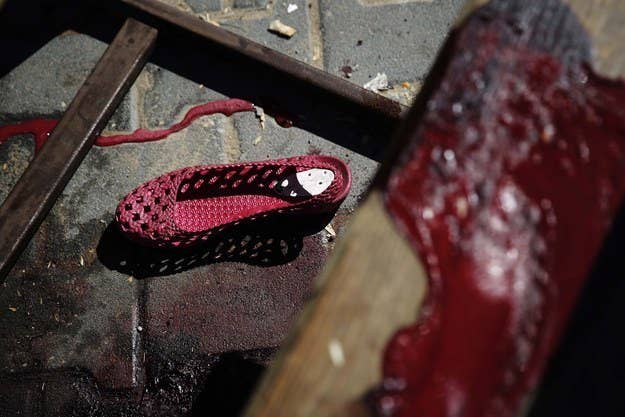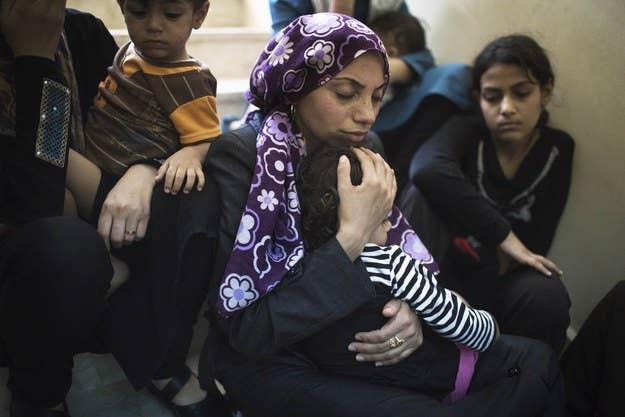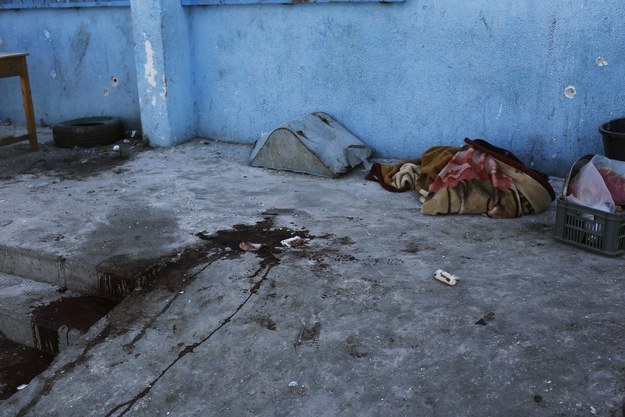
EREZ CROSSING, Israel — The only thing everyone appears to agree on is that early in the afternoon of July 24, 16 people were killed and more than one hundred injured at a United Nations school in the northeastern Gaza city of Beit Hanoun.
Pictures of death and destruction circulated widely in an attack that has come to symbolize nearly three weeks of war in Gaza. Israel first denied responsibility for the attack, saying it was likely a misfired Hamas rocket, then corrected itself and said a shell fired from an Israeli tank hit the school's courtyard, but that it hit no one. Now, four days later, these questions remain: Were hundreds of people gathered in the school's courtyard and if so why? How many explosions really hit the school? Who is ultimately reponsible?
"What we know is fact is that 15 people lost their lives in a place they should be safe," said Ahmed Shaheen, one of the surgeons who treated the wounded who was brought into the Kamal Odwan hospital near the site of the school. Fifteen people had been pronounced dead in the hours following the attack, and another died that evening. "Dozens more are still recovering from critical injuries. Everyone is asking how this could happen in a place they were sent to take shelter."

Beit Hanoun, nestled into the northeast corner of the Gaza Strip, has long borne the brunt of the frequent flare-ups between Israel and Gaza. Its position makes it ideal for Hamas militants to fire rockets into neighboring Israeli communities, and as the starting point for dozens of tunnels that snake their way from under Beit Hanoun to nearby Israeli communities in order to launch surprise attacks on Israel.
For the civilians in Beit Hanoun, the first orders to evacuate the area came more than two weeks ago when Israel launched Operation Defensive Edge. The area was rife with Hamas fighters who were engaged in close-quarters battles with Israeli soldiers. Israeli air strikes had been pounding the area for days, trying to take out Hamas rocket-launching sites. Those who could moved into central Gaza, where U.N. facilities quickly filled to the point of overcrowding. More than 800 people took shelter in the one place they thought they would be safe — the U.N. school in Beit Hanoun, whose exact coordinates were known to the Israeli military.
As the days passed, the fighting nearby intensified and many tried to make plans to leave.
Cecilia Goin, a spokesperson for the International Committee of the Red Cross (ICRC), said that on July 23 the ICRC got a phone call from civilians stuck at the school asking to be evacuated. The ICRC is one of the few organizations in Gaza that has the equipment necessary to evacuate people.
"We only move to evacuate when we receive requests from civilians," said Goin, noting that the group's "primary task is to tend to the wounded." Neither the U.N. nor the Israeli Defense Forces has the equipment or vehicles needed to evacuate civilians, so coordination to evacuate is nearly always done through the ICRC. "We try to find a window, a safe, agreed-upon window, to evacuate when we can."
An ICRC crew evacuated around 60 people on July 23, using a short lull in the fighting, she said. "That was the last time we were at the school," said Goin. "The next day, the day of the attack, we did not go to the school and we were not involved in any evacuation effort that day."
Multiple survivors of the attacks on June 24 said that sometime around noon, rumors spread around the school that the ICRC would be arriving to evacuate people.
"There are these rumors, and we don't know where they came from," said Goin. "We were not at the school, and we do not know who told people to gather at the courtyard."
Guy Inbal, a spokesman for Israel's Office of Coordination in the Palestinian territories (COGAT) told BuzzFeed in the wake of the attack last week that ICRC buses were on the way to the school to evacuate civilians at the time of the attack. He claimed that it was the U.N. which had not responded to requests issued by Israel for them to evacuate.
In the days since, both the ICRC and U.N. have disputed Inbal's claim in numerous interviews. The ICRC said that it did not receive a request to evacuate civilians from the school on July 24, and that no humanitarian corridor was in place for it to move people safely. Despite repeated calls to Inbal to clarify his statements, he did not answer a request for comment.
Meanwhile, all day Thursday, U.N. staffers were desperately calling their contacts in the Israeli army to inform them that civilians were sheltering in the school and that the fighting had become dangerously close.
Robert Turner, director of the U.N.'s refugee agency in Gaza, said the first call to COGAT came at 10:56 a.m., and that in the ensuing hours, 12 separate phone calls were made to the IDF to request a humanitarian window to evacuate civilians.

At 2:55 p.m., an explosion rocked the school. Multiple eyewitnesses said that in the minutes that followed they heard four or five more explosions, which fell in the vicinity of the school. "That's why we thought for sure, for sure, this is Israeli tank fire," said Yusef Mahmoud, a father of two who escaped from the school with only light injuries. "Because Hamas does not hit, exactly like that, the same place again and again."
In the hours after the attack, Israeli officials at first suggested it was the result of a misfired Hamas missile or mortar. Those mortars, many of them homemade, are notoriously clumsy, often falling within the Gaza Strip or firing wildly away from their intended targets. It is rare, however, that more than one missile would misfire in the same direction.
To bolster their case, Israeli officials released footage it said showed rockets being fired from within the U.N. school. (Hamas rockets have been found stored in U.N. schools in two separate cases in the past few weeks.) The video was first aired by NBC's David Gregory, during a live interview with Chris Gunness, a spokesman for the U.N.'s refugee agency. U.N. officials later said in a statement given to NBC that the school in the video was a different one, not under U.N. control, and its shape did not even resemble the U.N. school in Beit Hanoun.
Four days later, Israeli officials now say one of their tank shells did hit the school courtyard, but insist that it was empty at the time. Israeli military spokesman Peter Lerner told BuzzFeed that the "area in and around Beit Hanoun was part of an ongoing battle which included extensive firing on our forces."
"We responded with mortar fire in the direction of the perpetrators. One of the mortars we fired was misfired and landed in the middle of the courtyard of an U.N. school," Lerner said. He said that the IDF could only confirm a single round hitting the school, and that any additional fire that multiple eyewitnesses reported hearing or seeing was not the IDF.
Lerner also added that this footage filmed by an Israeli drone at the time of the attack shows the courtyard was empty.
View this video on YouTube
Israeli officials would not release any video from that day outside of that 10-second clip, and BuzzFeed could not independently verify the content of the video.
"Our visual surveillance indicates there was no one in the courtyard at the time an Israeli shell struck," said Lerner. "Therefore we conclude that reports that people were injured and killed there due to our fire are inaccurate. We believe those injuries are due to crossfire that took place in and around the school."
Lerner said the injured and dead evacuated from the school had either sustained previous injuries, or had been caught in other fighting around the area of the school. In a separate interview with the BBC, Lerner placed the blame more squarely with Hamas, saying that while an Israeli shell landed in the school's courtyard, it was Hamas fire that injured and killed the civilians.
U.N. officials said their own investigation into what happened at the school is ongoing, but point to numerous eyewitness and video accounts that show the blood-spattered courtyard of the school, implying it was filled with people. A statement from the U.N.'s refugee agency said, "There were hundreds of people at the installation when it was hit. We had staff at the school when the incident took place reporting in, as the shelling, which caused multiple fatalities and casualties, occurred. In addition we have spoken to numerous eyewitnesses. According to our reports, after the first shell, there were several others in the close vicinity of the school within a matter of minutes."
"It's impossible for me to even imagine people saying these people were injured hours or days before the event occurred. Any doctor who saw them, treated them, could tell you their injuries had occurred just then," said Shaheen, the surgeon who treated many of the wounded from the school. "We took shrapnel out of a baby's back. Do people really think a mother sat around with her baby's back covered in shrapnel, waiting to take him to a hospital so that she could blame Israel for his death?"

